- "闇に生き、光に奉仕するもの。そは我らなり。"
- ―ニッコ・ロマキャヴェリ.[src]
| アサシン | |
|---|---|
 アサシン教団の 紋章 | |
| 組織情報 | |
| 創始 |
アダムとイブ(伝説の) |
| リーダー | |
| 本部 | |
| 場所 |
フィレンツェ[5] |
| 関連団体 | |
| 宗教 |
色々 |
| 歴史 | |
| 発足 |
先史時代(伝説の) |
| 再編 |
1191 |
| 解散 |
2000 (organizationally) [4] |
| 捕捉 | |
| 主要メンバー |
|
アサシン, は、教団 ブラザーフッド、プトレマイオス朝では Hidden One、ローマ帝国では Liberalis Circulum (サークル・オブ・リベラルス);[8] or Hashshashinなど様々な名で知られ、中世盛期アサシンとテンプル騎士団は不倶戴天の敵対組織だった。全人類史を通しても彼らは見えない戦争を続けていた。
テンプル騎士団は人の自由意志を抑制し全人類の統率を求める一方で、アサシンは自由意志が新たな考えを生み出し人を成長させると考え、それを守るために戦った。
アサシン教団という名前ではないにしてもその存在は少なくとも紀元前456年から存在し、ローマ帝国、中世、イタリア・ルネッサンス、産業革命から21世紀まで存在している。
信条[]
- "Laa shay'a waqi'un mutlaq bale kouloun mumkin.
(アラビア語で「真実はなく、許されぬことはない」)" - ―アサシンの信条[src]
アサシン教団の
- "「汝の刃を罪なきものから遠ざけるべし。」「汝己の剣を罪なき者に振るうな」"
- "「ありふれた風景に溶け込め。」「民衆に紛れ同化し彼らと一体になり行動する」."
- "「教団の名誉を汚すことなかれ。」「兄弟を危険にさらすなかれ」"[3]
この信条は、自由のための戦いにはもちろんのこと、生活の私的側面にまで落とし込まれている。 アサシンは、可能な限り少ない犠牲からの大多数の救済を趣意とし、政治的且つ戦略的な手段をもって活動を行う。そして、アサシンは力や富を持たざる者、又は権力を濫用する者に対し抗う術を知らない者など力無き声の代弁・行者としての役割を担っている。[5]
弱者への多大なる献身にも関わらず、アサシンはその平和実現のための手段を嫌気され、社会より少なくない程度で疎まれている存在でもある。公共の場に於ける権力濫用者の暗殺や人海を利用し追っ手をかわすために、無実の大衆を混乱へ陥れるなど、その過激な手法が主因となっている。[3]
アサシンはアサシンブレードという目標に引導を渡す上で非常に効果的な道具を取り扱う。これに対し、毒の使用は卑怯な者のやり方であるとして、積極的使用は避けられている。<[5]
暗殺がアサシン教団に確実に利益をもたらすよう、標的選びには格別の慎重さと広範にわたる政治知識が要求される。従って、彼らには志操堅固の意志をもつ政治家の協力が必要不可欠となる。
暗殺に関する情報の収集は世界の諸都市に設立された評議会によりなされる。spies|諜報員は 貴族や統治者の監視、騒乱の種の調査、そしてテンプル騎士の発見などを行う。 獲得した情報は、軽重をとわずいかなる情報であろうと暗殺執行者に伝えなければならない。[3]
教団への加入[]
- 主な記事: アサシン教団への加入の儀式
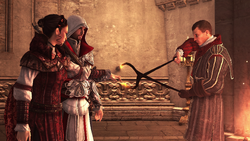
Claudia Auditore being inducted into the Assassin Order in 1503.
入団には二つの方法がある。アルタイル・イブン・ラハド、 エツィオ・アウディトーレ・ダ・フィレンツェ、そして デズモンド・マイルズのようにアサシンの一族に生まれるか、またはアプレンティスやショーン・ヘイスティングズのように勧誘を通してアサシン教団へ迎え入れられるかである。 [5][7] 信条の下自らはアサシンであると宣誓した後に、トレイニーはその真価の裁定を目的に、不特定量の期間任務をこなす日々を送る。エツィオの場合では正式にアサシン教団への加入を認められるに、テンプル騎士の陰謀を打ち砕かねばならなかったため、何年もの時を要した。[5] そして、アプレンティスはアサシン・ギルドに真のアサシンとして参加するために、世界をまたかけ課された任務をこなし、様々な経験を積まねばならない。[7]
訓練[]
アサシンは、その全人生を暗殺技術の向上に費やす。 早期より周囲の観察と予見する術が教え込まれる。
[3] 剣を中心として武器を使用した戦闘技術の会得も不可欠であり、これもアサシンにとっては生涯を通して向上しゆくべき技能である。しかし、このような訓練に於ける戦闘への比重にも関わらず、アサシンが最も貴ぶものは“秘匿”である。ステルス(隠密)はアサシンにとって最大の武器であり、生活に関連する全ての事項の前提にこれを置く。[3][5]標的に悟られることなく接近し、襲撃、そして雑踏へ消え行くのが常套手段である。[3] これを達成するために、平常よりアサシンは群衆に容易に紛れ込める衣装を身に纏う。アサシンブレードとは他に携帯する武器も、その時々に相応しいものを選択する。
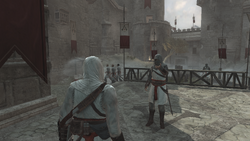
マシャフにて、教官と戦闘訓練を行うアルタイル
しかしながら、"全ての" アサシンが幼少より訓練を積むことができるわけではなく、これが可能であるのはアサシンの一族に生まれ育った場合のみである。
アサシンの血筋の外にある者や青年期などある程度成熟しきった後に加入する場合、又は状況によってはアサシンの一族に生まれた者であってもこれが適用されないこともある。その一例がルネサンス期のイタリア、あるいは現代など、テンプル騎士団の攻勢によって教団の力が大いに削がれ、アサシンの公における活動が非常に制限された状況下にある場合で、その場合はそれまで行われてきたような伝統的訓練、生活の中の訓練を受けることが不可能であった。[5]
教団への加入を認められれば、エツィオや後にその弟子となる者たちに代表されるトレイニー達は培ってきた経験や他のアサシンより教授された知識から、任務等に必要なモノを自力で作り出す術を体得しなければならない。
父、ジョバンニ・アウディトーレ・ダ・フィレンツェそして二人の兄弟、フェデリコ・アウディトーレ・ダ・フィレンツェとペトルチオ・アウディトーレ・ダ・フィレンツェの死に関連する者たちを暗殺する中で、エツィオはフリーランニング、肉弾戦そして、剣とメイスの扱い方を学んだ。 [5] 彼は生涯を通じて、パオラのような支援者や叔父であるマリオ・アウディトーレ、盗賊ギルドのローザなどから種々様々なアサシンのスキルを教え込まれる。暗殺術の基礎はアルタイルの写本を読むことにより体得した。[5] テベル島の隠れ家に本拠を構えるローマ・アサシンギルドのアプレンティスはエツィオ自身から直接指導を受けるようになる。ヨーロッパからアジアまで幅広い地域での活動を命じられるアサシンコントラクトを通じて独自の経験を得る。[7] 他派閥などとは別様に、アサシンには――とりわけ壊滅的攻撃を受けて秘密の地へ退避を余儀なくされていた際は――決まった戦闘方法が定められているわけではない。彼らの代名詞ともいうべきアサシンブレードは例外として、各支部は地域毎に有効であると認められた武器や戦闘方法を採用する。トルコ支部では、反り曲がった短剣を、中国のアサシンはカンフーを好んで使った。 その他特筆すべきアサシンの訓練があるとすれば、それはマニューバビリティ(機動性)である。アサシンがマスターアサシンのランクに達した場合、そのアサシンは同時にパルクールやフリーランニングの熟練者であることをも証明されたと言える。
公衆の目に留まれば異様に映るが、通常の方法では侵入できない地域にもこの技術があれば難なく足を踏み入れることができる。壁を這って、市中にあるビューポイントへ登ったり、フリーランニングは相対する敵に優位に立ち回ることを可能にし、目的地への素早い移動にも寄与する。
装備[]
アサシンは毒から銃まで、使い捨ての武器を何種類も使いこなす。教団設立当初、アサシンは標準の衣装や装備を持たなかったが、これは外見や毒、弓、そしてその他あらゆる武器等を効果的に運用するためであった。しかし、時代が下り中世も中期へ入ると、教団を表現する色を白とし、標準服としてフード付きのローブが着用されるようになった。トレードマークであるアサシンブレードもこの時期より使用が確認されている。 アサシンはその他に剣、短剣、ダガー、そして投げナイフなどを扱う。
ルネサンス期、アサシンの装備に著しい変化が加えられたわけではないが、いくつかの武器が標準装備として加わった。マスターアサシン・エツィオは仕込み銃、クロスボウ、爆薬、そして二本のアサシンブレードを使用した。オスマン帝国に於けるアサシンはフックブレードなるアサシンブレードの改良版を開発した。またアメリカ独立戦争の時代に、モホーク族のアサシンであるラドンハゲードンは当時アメリカにおいて盛んに使われたトマホーク、弓、ピストルを自由自在にした。
死者への弔い[]
伝統的に、アサシンは死した同胞へ多大な敬意を払う。彼らの同胞は、地下室に埋葬され盛大な式が行われる。然るべき処置を施された死者は生前身に付けていた赤い飾り帯と共に埋葬される。最上位のアサシンは、大きな部屋が用意され、表が当人の像となっている蓋に教団の紋章があしらわれた旗が立てられた石棺に安置される。[5]
そして、アサシンは身内のみならず、状況が許す限りで、暗殺対象にもその今際の際に告別・慰安の言葉を捧げる。
アサシンの歴史[]
成立[]
アサシンの歴史は古く、その原点は何世紀も前に見つけることができる。アサシンはかつて来たりし者と人類が交わることにより誕生した。アサシンの始祖は、外見こそ人のそれではあったが、鷹の目を筆頭に様々な感覚・能力をかつて来たりし者より継承していた。[5]
共和制・帝政ローマ[]

ユリウス・カエサルを暗殺するアサシン
共和制ローマ時代、アサシン教団は当時ローマの政権を担う立場にあったSPQR[Senatus Populusque Romanus (元老院とローマの人民)]と隠然と敵対していた。SPQRは後に生まれるテンプル騎士団の母体となった。[5]
当時の教団がどのような階級制度を採用し、活動していたかは、要人の暗殺など主だったものを除いては、ほとんどわかっていない。 前44年、元老院に議員として潜入した40名のアサシンが、ローマ帝国のディクタトル(独裁官)を宣したガイウス・ユリウス・カエサルの暗殺を企てた。マルクス・ユニウス・ブルトゥスはガイウス・カッシウス・ロンギヌスより暗殺の任を与えられる。そして、コロッセオの地下神殿でかつて来たりし者によって創り出されたいくつかの光景を見た後、アサシン達は暗殺を決行。40人のうちの23人がカエサルを突き刺し、死へと追いやった。カエサルは元老院で息を引き取った。[7] 暗殺後、アサシン達は方向を異に脱出を試みたが、そのほとんどはカエサルの部下に阻止され、殺害された。 その後、ブルトゥスは フィリッピの戦いにて劣勢を強いられ、果てに陣中に自害した。 アサシン教団は、ブルトゥスを復活させようとエデンの布を使うが、失敗に終わっている。[6]
ローマ帝国[]
前30年、ローマ帝国初期、エジプトのアサシンアミュネットは毒蛇を用いて生前カエサルが愛したエジプトの女王、クレオパトラを殺害。 41年1月24日、第三代ローマ帝国皇帝カリグラはアサシンレオニウスによって殺害される。剣で突き刺されたことを除いて、その他状況などは謎に包まれたままである。[5]
259年当時サークル・オブ・リベラスという名で活動していた後のアサシン教団は、アクシピターとアクィラスの両アサシンにアンクの守護を命じた。当初、アンクはアクィラスの父ルシウスが所有していたが、テンプル騎士であり元老院議員でもあるガイウス・フルブス・ブルトゥルの手によりルシウスは殺害、アンクも盗まれてしまった。アクィラスはこれを奪還せんと追随し、テンプル騎士フォースティンと邂逅、排除する。彼からこの事件の首謀者はブルトゥルであるという情報を引き出す。果てに、アクィラスはアンクを取り戻し、ブルトゥルも殺害するが、ルグドゥヌムにて捕まりそのまま捕虜として生涯に幕を下ろす。アクィラスの従兄弟、アクシピターは以前にもグラチュスの離反の際に彼の命を救ったが、アクィラスの捕縛を聞いたこの時も彼のもとへ急行する。しかし、この努力は虚しくも結実することはなかった。既の所でアクィラスの妻バレリアを救出し、彼女から衛兵のルーチンワークを聞き出す。そして、アクシピターは彼女と共に衛兵達を倒し、アンクを回収。バレリアはアクィラスの亡骸と共にアンクも埋葬をした。
中世盛期[]
中世期、テンプル騎士は公的に名実共に騎士としての称号を得、テンプル騎士団となる。 1090年、ハサン・サッバーフの指導下にあったアサシン教団も公衆の認知を受ける組織となる。 彼の方針の下、公における暗殺の数は飛躍的に増え、それまで見えなかった不当な支配に気づいた人民による圧政者たちに対する蜂起を支援した。[9]
1170年代、アサシンはサラセン人と敵対的関係にあった。[10] 1174年、13人のアサシンがダマスカス近くに布陣するスルタンサラディンの野営地に潜入する。が、間もなく発見され逃走を図るも、一人はサラセン人の将軍の手によって、その他のアサシン達も全て兵士に殺害されてしまう。[11]
1176年、大軍を引き連れたサラディンがアサシンの牙城マシャフを包囲する。 アフマド・ソフィアンとウマル・イブン・ラハドの二名はサラディンの所在地を特定、その幕舎に侵入し、一枚の羽と半ば脅しの内容が綴られた便箋をくくりつけたダガーを残した。ウマルは部屋全体に散りばめられた白色の粉や灰を巧みに避け、いまにテントから脱出しようとしたところでスルタン自身に発見される。ウマルはその中途で貴族を殺してしまう。アサシン教団とサラセンとの間に停戦協定が結ばれたが、アサシン側はその代償としてウマルの命を払った。[10]
1189年、ハラスが敵と内通。アル・ムアリム及び他三名のアサシンを捕らえ、十字軍をマシャフへと招き入れた。ほとんどのアサシンが希望を失いかけていたその時、アルタイルが帰還。方々を転戦し味方を解放、そして再びまとめあげ反撃に出る。アルタイルは砦を登り、内部へ潜入。エデンのリンゴの在りかを探るハラスをそこで仕留める。 翌年、アサシンは十字軍を解散せしめ得る力を持つオブジェクト、聖杯の探索を開始する。 絶対にテンプル騎士の手に渡したくないアル・ムアリムは、全幅の信頼を置くマスターアサシン、アルタイルを派遣する。 アルタイルはソロモン神殿を探索中、テンプル騎士を数人殺し、中枢で目的の場所を見つける。が、そこにはテンプル騎士の隊長、バジリスクがすでにおり、アルタイルに「“聖杯”とはオブジェクトではなく、人間の女性である」と告げ、攻撃を開始した。 無事に神殿を抜け出したアルタイルはバジリスクを殺害、そこでテンプル騎士がアッコの上水に大量の毒を流し込む計画を立てていることを知る。 敵の謀略を挫き、事無きを得たアルタイルは、引き続き聖杯を求めイェルサレムヘ向かった。アルタイルは、当地で彼女を発見。彼女はアウダと名乗る。アウダの協力を得、アルタイルは教団に対する背信者、Harash,を抹殺する。そのままアウダと共に陰遁生活を送ろうと逃走を図るが、アウダはバジリスクに捕らえられてしまう。
辛くもバジリスクを殺害することに成功するも、アウダを見つけ出すことはできなかった。
数年後、アルタイルは彼女の骸を発見。手を下した者を殺害する。
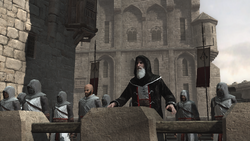
マシャフの砦にて、アルムアリムとそのアサシン達
1191年、アサシンはロベール・ド・サブレ率いるテンプル騎士団と対峙していた。第三次十字軍による混沌の中、アサシン側は、テンプル騎士団がソロモン神殿に眠るエデンのリンゴ2に野心を抱いていることを知る。 テンプル騎士の思惑を阻止すべく、アサシンも対抗。甚大な犠牲を払うも、レリックの奪取に成功した。
カダール・アルシャイフは死に、マリク・アルシャイフは重症を負い、そして、終いにはマシャフの門にまで敵の侵攻を許し、アサシンは窮地に陥ってしまう。が、砦の側面に秘匿して備え付けられた巨木の丸太を落としたことが奏功。テンプル騎士の軍勢を砦及び城下町から退けることに成功した。[3]
テンプル騎士の襲撃後、アルタイルは多大なる人命の喪失の責任を負って厳正な降格処分を受けると共に、聖地を堕落させている九人の権力者を排除する任を与えられる。
十字軍、そしてサラセン両軍勢からなる要人の暗殺計画を遂行の途、アルタイルにある疑念が訪れる。 「聖地をかつてあった状態へ戻すのが本当に良いのか?」 これまで手にかけてきた人間は確かに過ちを犯してはいたが、その動機に於いては純粋そのものだったのではないか? そして、この価値観は師アル・ムアリムより教示されたものだが、「目的は手段を正当化する」というこのやり方は、教団の指針に抵触するものではないか…?
任務を推し進め、疑念は深まる一方であったアルタイルはやがて真実を知る。彼らは純粋なテンプル騎士などではなく、テンプル騎士の陰謀を阻止し、アサシンに利するためにテンプル騎士に仕えた者たちであった。[3]
1191年の暮れ、アサシン教団はテンプル騎士に対し、優勢となった。ロベール・ド・サブレ[テンプル騎士の[グランドマスター]]がこの世を去ったが、その時ある裏切り者が教団に激しい攻撃を開始していた。 その名はアル・ムアリム、彼はかつて10人のテンプル騎士リーダーを構成する騎士の1人であった。アル・ムアリムはついにその正体と恐るべき目的とを明かし、アルタイルに対峙したが、奇しくもテンプル騎士たちの排除の命を授けたアルタイルその人に始末されてしまう。 アル・ムアリムの死後、大きく力を削がれた教団を再建せんと気鋭であったアルタイルが空いた指導者の座に就いた。[3]
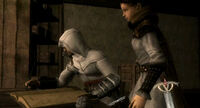
写本を著すアルタイル
教団の体制を建て直したアルタイルは、テンプル騎士がイングランド王・リチャード1世より買い取ったというキプロス島を解放すべく出立する。目的を達成し、マルマン・ブシャールの殺害とTemplar Archiveの奪取に成功したアルタイルは、[12]その後写本━━アルタイルがエデンの果実より獲得した知識を書き記した本━━の作成に心血を注ぐ。[5][12] 結果的にこれらの知識は、新しい暗殺方法や隠されていた世界の真実など教団にとり尋常ならざる発展を産み出すこととなる。[5]
1209年、エデンの果実から秘宝はこの他にもいくつか存在するという情報を得、アルタイルは世界各地へとアサシンたちを派遣した。[9]
Eventually, it was decided that the Piece of Eden was too great a threat to keep in Masyaf, and the decision was made to store it on the island of Cyprus, in the Limassol archives.[12] However, Altaïr had started this rumour to keep away curious eyes. In actuality, he held on to the Apple until the end of his life, taking it with him to his library, though he did hand over the Codex and the keys to his library to the Italians Niccolò and Maffeo Polo.[1][5]
In the year 1217, Altaïr set out with his wife Maria and son Darim to kill Genghis Khan, leaving Malik as the temporary leader. The Khan had made a rapid westward advance with his army and Altaïr suspected that he possessed a Piece of Eden. They met up with a Mongolian Assassin Qulan Gal, and the three Assassins worked together to end the threat. Ultimately Darim and Qulan succeeded in killing the Khan in 1227.
On his return to Masyaf, Altaïr found that his rival Abbas had taken over the order, imprisoning Malik, and killing Altaïr's younger son, Sef. After Altaïr's arrival Malik was killed as well. Abbas attempted to take the Apple from Altaïr, causing Altaïr and Darim to leave Masyaf and Maria getting killed at the hands of Swami. Both Altaïr and his son killed several Assassins along the way.
After the escape Altaïr became obsessed with the Apple, driving Darim, and Sef's family away. The Apple led him to the Memory Seals, and taught him how to make several advanced gadgets.
Around 1247, Altaïr returned to Masyaf and found it in disrepair. He rallied several Assassins who were loyal to him, and turned several of Abbas' henchmen to his side. Finally they assaulted the fortress, making sure not to harm anyone other than the Assassins who had defied the Creed. Altaïr finally shot Abbas with the Hidden Gun, marking the first usage of this weapon.
The Mongol threat continued advancing west however, and Altaïr decided to abandon their fortresses, going underground and continuing their activities in secret. He trained the travelers Niccolò and Maffeo Polo into Assassins in the year 1257, escorting them out of the city. He tasked them to set up guilds around the world as they traveled.
Darim was one of the last Assassins to leave Masyaf, Altaïr stayed in his Library with the Apple, and died there with the final Memory Seal in his hand.
Late Middle Ages[]
- "In this modern age, we are not as literal as our ancestors; but our seal is no less permanent…"
- ―Mario Auditore at Ezio's official induction into the Assassin Order[src]
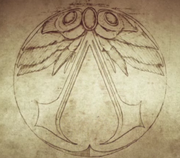
Italian Renaissance variation of the Assassins' emblem.
During the Late Middle Ages, the Order continued to thrive, despite being forced to adopt an even more secretive and isolated existence. When the Renaissance, a cultural movement, started in Italy, the Assassin Order had apparently "gone underground" and primarily focused themselves in Italy, where the headquarters of the Templar Order were also located. As the Templar Order survived in more inconspicuous ways, Altaïr believed that the Assassins too had to change tactics, so as to live on and made the Order a secret organization once again.[5]
In the early 14th century, the Assassins manipulated the French king, Philip le Bel to try and destroy the Templars. They made the Church brand the Templars heretics, turning their own weapon against them, with the intention of finishing off the Templars. They managed to get the Templar Grand Master, Jacques de Molay burnt at the stake, however, his nine most trusted men had escaped after he had passed on the knowledge of the ancients, and the order continued to survive.[13]
By 1321, various members of the Assassin Order had successfully integrated themselves into modern day life of middle Italy, widely unknown to the average folk. That same year, a young sailor by the name of Domenico, the son of an Assassin, was apprenticed to the poet and Assassin Dante Alighieri, who had been tasked with transporting the Codex of Altaïr from Venice to Spain.[14] Upon his death, however, the undertaking fell instead to Domenico. During the voyage, pirates under the employ of the Templars ambushed the ship looking for the Codex, consequently killing Domenico's wife. Fortunately for the Assassins, Domenico managed to break apart the Codex and hide its pages from the pirates before he and his son were forced overboard.[14]
Eventually returning to Venice, Domenico found his father and his patron, Marco Polo, an ally of the Assassins, dead. Thus, Domenico emptied the bank accounts of Messer Polo, and traveled to the city of Florence under the assumed name of Auditore. He eventually constructed the Villa Auditore in the city of Monteriggioni, which became the center of the Assassin Order in Italy up to the year 1500.[14]
Despite the order "modernizing" since the 12th Century, they still retained many of the rituals and practices, albeit altered. The practice of removing one's ring finger had been stopped, although the seal of the Order was branded upon the finger instead with hot iron. Although significantly fewer in number, the Assassins were supported by the courtesans, thieves and condottieri of Florence and Venice; the guilds of which were each run by a member of the Order.[5]
During this time period, the Assassins entered another period of increased hostility with the Templars, who were attempting to overthrow the ruling House of Medici in Florence, and the Doge of Venice. Having already killed the Duke of Milan[15] in 1476, Rodrigo Borgia, the Grand Master of the Templar Order, brought the noble families of Pazzi and Barbarigo together[15] to accomplish his goals. Entering into conflict with the Assassins, Borgia dealt a crippling blow to the Order in 1476, when he had executed the experienced Assassin Giovanni and his two sons, Federico and Petruccio, although a third son, Ezio, managed to escape. With the aid of Ezio, the Assassins were able to counter Borgia's plot over a twenty-three year campaign, defeating him at every turn.[5]
In 1487, the Order of Assassins learned that the Templars had retrieved another Apple of Eden from the island of Cyprus, and deemed its capture necessary. Following the artifact from L'Arsenale di Venezia, Ezio managed to overpower and replace the Templar guard carrying the artifact. Under this guise, Ezio met with Borgia himself, and the two engaged in battle. Borgia fled upon the arrival of other Assassins, and the artifact fell once again into the hands of the Assassins. The Assassins of this age, however, were unaware of the nature of the artifact, although they did recognize it as one of the Pieces of Eden mentioned within Altaïr's Codex.[5]
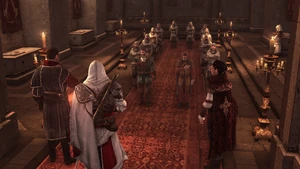
The Assassins in Rome.
By 1500, right after Cesare Borgia besieged the city of Monteriggioni, murdering Mario Auditore and once again claiming the Apple for the Templars, Ezio Auditore had moved to Rome, meeting up with Niccolò Machiavelli and laying the foundations of a new "brotherhood" of Assassins. Utilizing the mercenaries, thieves and courtesans of Bartolomeo d'Alviano, La Volpe and Claudia Auditore respectively, Ezio's brotherhood worked to combat the influence and power of the Borgia family, and by extension the Papacy itself. Headquartered in an underground store-room owned by Fabio Orsini, on Tiber Island in the center of Rome, the Assassins begun to spread their influence throughout the city, recruiting Rome's own citizens as Assassin Apprentices under Ezio, eventually becoming inducted and branded into the Order as Assassins themselves. Under the instruction of Ezio, many Assassin recruits undertook a variety of missions across Europe and Asia in cities such as London, Paris, Barcelona, Lisbon, Moscow and Calicut, killing and sabotaging Templars, their allies, and corrupt men in power, and defending and aiding their Assassin brothers and sisters, as well as anyone willing to stand against the Borgia and the Church.[7]
Over a period of three years, Ezio's brotherhood whittled away the Borgia family's power, and with the murder of Rodrigo Borgia at the hands of his own son, and the arrest of Cesare by the Papal Guard of Julius II, the Templars' influence over the city of Rome was shattered.[7]
Three years after Siege of Viana in 1507, when Ezio ended the threat of Cesare Borgia, the Assassin Grand Master traveled to the ancient Assassin fortress of Masyaf, on a pilgrimage to learn the origins of the Order. When he arrived, he discovered that the fortress had been overrun by the Templars, who were searching for the five Seals of Altaïr, which would combine to unlock a secret weapon hidden by Altaïr. With one seal already in the Templars' possession, Ezio learned that the remaining four were hidden throughout the city of Constantinople. From there, Ezio made his way to the city, in the hopes of obtaining the remaining seals.[1]
When he arrived in Constantinople, Ezio was welcomed by the guild there, led by Yusuf Tazim, and learned how to use their unique weapons. With the knowledge made known to him that the Templars had taken over the Byzantine remnants, and in the recent years, had been attempting to overthrow the Ottomans, Ezio began to take a leading role in the conflict. He retook all the Assassin Dens around the city and trained seven recruits to the rank of Master Assassin, assigning each to one of the dens. The Constantinople Guild also worked to help liberate and spread Assassin influence in other cities, namely Bursa, Rhodes, Marseille, Damascus, Jerusalem, Madrid, Lisbon, Tunis, Tripoli, Athens, Algiers and Alexandria, where they slowly whittled away Templar Control, rebuilt the cities and protected them from attacks by the Templars. They also rescued captured Assassins in these cities, and helped those who opposed the Templars. They were responsible for destroying the compound of the Knights Hospitalier.
Together with Yusuf, Ezio protected the Ottoman prince Suleiman from the Templars, while continuing his search for the keys. Befriending a Venetian lady, Sofia Sartor, she deciphered a map containing the location of the keys. After finding 4 of the keys to Altaïr's library, Ezio travelled to Cappadocia, after asking Yusuf to protect Sofia at her shop, to hunt down Manuel Palaiologos and find the final key. On doing so, he discovered that Manuel was not the true leader of the Byzantines, but Suleiman's uncle -- Ahmet -- was.
On his return to Constantinople, Ezio made his way to Sofia's shop, to find that Yusuf had been killed and Ahmet had captured Sofia, demanding the keys in exchange. However, after a full scale assault on the city's Arsenal, Ezio chased him over the countryside, culminating with Ahmet's brother, Selim, killing Ahmet by throwing from a cliff.
From there, Ezio and Sofia travelled to Masyaf and unlocked the library of Altaïr, where Ezio attempted to communicate with Desmond. Deciding that his mission was over, Ezio left his sword and hidden blade, giving up his life as an Assassin.[1]
On his return to Italy, Ezio appointed the Assassin Lodovico Ariosto as Mentor of the Italian Assassins and then retired from the Order, marrying Sofia Sartor and having two children with her, Flavia and Marcello Auditore, settling down on a Tuscan vineyard.
As the Templars had been severely weakened in Europe, the Assassins began collecting and studying several Pieces of Eden. In 1510, Francesco Vecellio hunted down Niccolò di Pitigliano, recovering the Shroud.
In 1519, Giovanni Borgia was secured a position aboard Hernán Cortés' ship, which was sailing to the New World. After the Spanish troops began to ransack Tenochtitlan, Giovanni recovered a Crystal skull from the Mayan city, assassinating one of their priests to obtain it. On bringing it to Paracelsus for study, the Assassins found that it was not one of the Pieces.
In 1527, Giovanni accidentally read a tome belonging to Paracelsus and succeeded in crafting the Philosopher's Stone. After discovering that the tome was one half of the Book of Abraham, he searched for the other half with Maria Amiel, Paracelsus' assistant, but only found a translation. However, he did develop a relationship with Maria, with the two of them becoming romantically involved and later marrying each other.
In 1542, after studying the Crystal skull over a long period of time, Giovanni found out that it could be used to communicate over large distances, seeing the face of a Chinese man in his mind.
Around this time, the Chinese Assassins were fighting desperately against the Templars. Several Chinese Emperors came to power through Templar support, who would then orchestrate the mass killings of Assassins. One such emperor was Yongle, who was killed by the Assassin Li Tong in 1424.
When Emperor Jiajing came to power, he nearly destroyed the Brotherhood in China, though a handful of Assassins fled west for support. Shao Jun and her Mentor escaped to Italy, though Jiajing's men killed Shao's Mentor along the way, leaving Shao to fend for herself. With no alternative, she went to Ezio to seek guidance and support.
Though he initially wanted nothing to do with the Assassins anymore, he eventually relented and taught her how to rebuild her Brotherhood. Shao, armed with this knowledge and a box that Ezio told her to open only if she lost her way, went back to China, vowing to rebuild the Brotherhood, no matter how long it took.
Colonial America[]
As the reach of the Old World spread to the New, the Assassins' followed to ensure they were able to protect it from any advances the Templars made. In 1503, the Italian Assassins under Ezio, sent their recruits to recover a map of the New World made by Piri Reis. Using this map they too began to send their men to America.
In 1510, the Assassins in Florida recruited Alonso Carlo, and his adopted son, Miguel Ramón Carlo de Lugo, to their cause. In 1521, Carlo was tasked with stopping the explorer Juan Ponce de León from reaching the Fountain of Youth, where they knew he would find a Piece of Eden. While Miguel distracted León in conversation, a poisoned arrow killed León, and Miguel escaped.
In the mid 18th Century, during the French and Indian War and the American Revolutionary War, at least four Assassins named Ratonhnhaké:ton,[16] Aveline de Grandpré[17], Agate and Achilles were operating in the area.
In 1865, the Templars planned an assassination attempt of their own on the incumbent United States President; Abraham Lincoln. Though it succeeded, the murderer, John Wilkes Booth was later hunted down and killed by Assassins.[5]
Modern times[]
- "In the old days, that usually meant killing anyone who became too powerful or greedy. […] These days, it means subversion of established regimes. […] Countries. Corporations. We change the system from within."
- ―"The Mentor", in 2000, on the Assassin Order.[src]

One of the Pieces of Eden, the Staff, destroyed in the Tunguska explosion.
By the late 19th century, the Russian sect of the Assassin Order, the Narodnaya Volya (People's Will), played a vital role in overthrowing the Tsarist rule over Russia. The Assassins strongly assisted their close ally, Vladimir Lenin, the leader of the Bolsheviks – as Lenin's brother was an Assassin himself. Due to the efforts of the Assassin Nikolai Orelov, the Templar Tsar Alexander III died of kidney failure and the Staff of Eden was destroyed in the Tunguska explosion. Without power, Tsarevich Nicholas II was removed from the throne and Russia became communistic.
By the 20th Century, the tactics and practices of the Assassin Order had changed greatly.[4] Whilst the Order of Assassins had kept to their policy of remote camps and isolation,[3] the Templars had begun to infiltrate society further; taking the form of many publicly known corporations such as NASA[5] and Kraft,[7] which all secretly fell under the shadow corporation Abstergo Industries.
The Templars Winston Churchill, Joseph Stalin, Franklin D. Roosevelt, and Adolf Hitler planned a war that would place the Templars in control. At the end of the war, Hitler was supposed to kill his double, created by the Piece of Eden in his control, and then escape. However, the Assassins spoiled this victory by assassinating Hitler as he exited the bunker his body double was placed in.
The Assassins relied less upon killing powerful or greedy individuals, and more on changing the "established regime" from within, using politics as well as the blade to achieve their aims, such as rigging elections to keep Templars out of office.
The American presidential election of 2000 was one such election, with the Templars attempting to place their puppet George W. Bush into power, and the Assassins backing Al Gore.[4]
By the year 2000, the hidden blade had become a largely ceremonial weapon.[4] In the meantime however, the Templars continued to search for and investigate the various Pieces of Eden they discovered throughout this period,[3][5] whilst the Assassins continued their war against them; notably being responsible for the destruction of at least one Templar-controlled base in Siberia in 1908, known in public as the Tunguska explosion.[5] However, by the year 1985, the Templars, under the guise of their front company Abstergo Industries, had begun kidnapping Assassins or those related to them in an attempt to locate even more Pieces of Eden.[7]

The Mentor's death at Cross' hands.
That same year, a child codenamed Daniel Cross, a descendant of the Assassin Nikolai Orelov, was kidnapped by Abstergo's Lineage Research and Acquisition department and entered into the Animus Project.[2] Years later, in 1998, Daniel joined the Order as a prospective, but with a mission to find the then-current Mentor. Two years later, he was granted his wish and inducted into the Order by the Mentor himself; Cross subsequently murdered the Mentor with the very hidden blade he had been bequeathed by his victim just moments before, as a result of a neurological impulse instilled in him by Warren Vidic during his time as an Abstergo captive.[4] Cross's actions directly led to the fall of the Assassin order, as he compromised virtually all of the Assassin camps around the world that he had visited in search for the Mentor upon returning to Abstergo Industries, which forced the Assassins even further into hiding. Other notable Assassins held captive by Abstergo included Clay Kaczmarek and Desmond Miles – both descendants of Ezio Auditore and Adam.[3]
After the Mentor's death, William Miles began to take a prominent role in the Order's functioning, and became their de facto leader. It was his decision of raising Lucy Stillman outside the Order after the age of seventeen, so that all her ties to the Assassins were cut, and she could infiltrate Abstergo.
Sometime around 2008, he also recruited Clay Kaczmarek to the Order. Tasked with infiltrating Abstergo and discovering information about them, he returned successfully with a memo detailing the allocation of Abstergo Industries' budget, along with their funding of the Animus Project. With this information known to the Assassins, a plan was devised for him to get caught by their Lineage Research and Acquisition department as Subject 16, and was to be rescued later by Lucy. However, years of isolation had caused her to turn against the Assassins, and once Clay learned of her defection through hacking into Abstergo's systems and uncovering security footage, she did not help him escape when the time came, leading to his subsequent suicide.
- "We lost two more teams last night. That's eight more of us just... gone."
- ―Lucy Stillman, 2012.[src]
Later on, the Templars tracked down Desmond Miles, William's son, who had left the Order in 2003.
Using Desmond, Abstergo managed to obtain a map of the locations of the Pieces of Eden across the globe, and subsequently begun their attempts to claim them. When Desmond began to suffer from the Bleeding effect, Warren Vidic told Lucy to take him somewhere where he would feel safe, as part of a plan code-named "Project Siren". Not long after, the Assassins were able to free Desmond with the "aid" of Lucy Stillman, as well as obtain their own copy of the map.[5] Following this, Desmond agreed to aid the Assassins in their quest to defeat Abstergo, mostly for revenge, but also for closure.
Utilizing the Animus 2.0, a copy of the machine used by Abstergo to explore his genetic memories previously,[3][5] Desmond followed the memories of Ezio Auditore, adopting his skills in combat and free-running, while the rest of the Order concentrated to locating the Pieces of Eden before their Templar counterparts. Despite this, however, the war with the Templars had taken a turn for the worse. With their numbers dwindling, the Order of Assassins was in danger of losing the war.[5]
As technology progressed, so did the weapons used against the Assassins. By 2012, the Templars were using cell phone towers and satellites to track them down. As a result, Desmond and his group had to take refuge within the Sanctuary, deep beneath the city of Monteriggioni. By this point, the Order was using at least one e-mail network, known as the Hephaestus Email Network, in order to facilitate communications.[7]
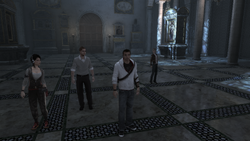
The Assassins inside Santa Maria in Aracoeli.
In the latter half of 2012, an Assassin team made up of Lucy Stillman, Rebecca Crane, Shaun Hastings and Desmond Miles discovered the Colosseum Vault – after Desmond had relived Ezio's memories in Rome through the Animus – and infiltrated it, securing the Apple of Eden that Ezio had hidden there centuries before. On contact with First Civilization artifact, Desmond's body was taken over by the ancient being Juno, who forced him to stab and kill the Assassin-turncoat, Lucy. This helped to ensure that the Templars couldn't get their hands on Ezio's Apple and kept Desmond safe from Templar influence from within the Assassins. Due to this event, the team and the Apple were brought to William Miles and the Order, in turn securing one of the ancient artifacts for the Order's cause.[7]
Also, around this time, an Assassin team in Moscow were chasing a potential lead on a Piece of Eden. However, as William Miles stated, this was some of the only good news they had got. There were teams in Osaka and São Paulo. In Osaka, the team was being tailed, so they had gone dark. In São Paulo, a leak was confirmed and the team was working on flushing it out. The team in Denver were even worse off. They had lost contact without informing, and their safe house was empty. This meant that they were dead or captured, or that they had gone dark without informing the Headquarters.
Known Assassins[]
- "The seeds were planted as two worlds became one. Behold, the Assassins, the children of two worlds!"
- ―Clay Kaczmarek.[src]
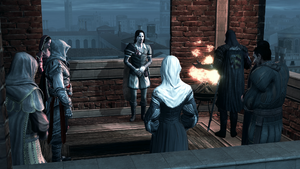
Ezio's initiation into the Brotherhood.
The Assassins had existed since before the turn of the first millennium; several known figures included Darius, Iltani, Wei Yu,[5] Gaius Cassius Longinus, Marcus Junius Brutus and their co-conspirators,[6] Amunet and Leonius.[5] Historically however, the forebearers of the Assassins have existed since before recorded time, possibly reaching as far back as Adam and Eve.[5]
Medieval and Renaissance periods[]
During the Third Crusade, the Syrian sect of the Order of Assassins was mainly made up of native, Syrian-born individuals; although some, like Altaïr, were born to parents of both religions. Led by Al Mualim,[3] and later Altaïr Ibn-La'Ahad himself,[5] other members included Harash,[12] Malik and Kadar Al-Sayf, Rauf, Abbas, Masun, Jamal,[3] and Qulan Gal, the death-bringer of Genghis Khan.[5] Allies also included various individuals, such as Adha,[18] and even former Templars like Maria Thorpe.[5][12] Others included Dante Alighieri, Maffeo, Marco and Niccolò Polo, and Domenico Auditore,[5] the founder of the Auditore Villa.
Later on, during the Renaissance, the Order's numbers had dwindled significantly. Having become much more secretive, members of the Order often had occupations and lives outside of the Order, ranging from artists[19] to thieves[5] to royal treasurers.[20] They included the Florentine banker Giovanni Auditore da Firenze;[5][15] his brother Mario Auditore, caretaker of the Auditore Villa and condottieri leader; Federico Auditore da Firenze and his brother Ezio Auditore da Firenze; Paola and Teodora, the heads of the Florentine and Venetian courtesans respectively; Antonio de Magianis, the head of the Venetian Thieves Guild; La Volpe, the head of the Florentine Thieves Guild; Niccolò Machiavelli, a writer and head of the Florentine Mercenaries; Bartolomeo d'Alviano,[5] condottiero of Venice; Perotto Calderon, undercover in the employ of the Borgia.
Others included Giovanni Borgia, the illegitimate son of Calderon and Lucrezia Borgia; Paracelcus, Swiss scientist and alchemist; Francesco Vecellio, Renaissance painter,[6] Tessa Varzi and Cipriano Enu,[6] Rinaldo Vitturi, the keeper of the Shroud,[6] Ridolfo Fioravant and Pietro Antonio Solari, spies working undercover as architects on the Kremlin,[7] Luis de Santángel and Raphael Sanchez, finance minister to Ferdinand II and treasurer of Queen Isabella I respectively;[20] Yusuf Tazim, the leader of the Constantinople Assassin Guild; Piri Reis, a top navigator and cartographer to Bayezid II and Master Assassin; Sofia Sartor, a book shop owner and eventual wife to Ezio Auditore; Suleiman I, a young prince and eventual successor to the Ottoman Empire's throne, and Dogan and Azize, two lieutenants of the Constantinople Assassin Guild.
Once again, the Order had many allies amongst the common folk of Italy, as well as amongst the nobility. Foremost among them was Leonardo da Vinci, Ezio's closest friend and a genius of invention. Others included Caterina Sforza,[21] the Countess of Forlì;[5] Lorenzo de' Medici, the ruler of Florence;[5] Agostino Barbarigo, the Doge of Venice from 1486;[5] and the famed explorer Christoffa Corombo.[20]
By 1501, Ezio Auditore and Niccolò Machiavelli had begun training new Assassin recruits in the Order from their Tiber Island Base in Rome. In 1503, Claudia Auditore, sister of Ezio, also joined the Order.[7]
Modern times[]
At the turn of the 20th century, the Assassins' Order had spread as far the Russian Empire, with a strong presence in and around Petrograd. Members of the Narodnaya Volya were in fact members of the Assassin Order. Some known Assassins include Nikolai Orelov and Aleksandr Ulyanov, the older brother of Vladimir Lenin.[2]
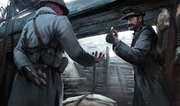
The British medic and Erich Albert.
During World War I, there was an Assassin on the Western Front, an unidentified medic fighting for the British on the front line. The medic assassinated Erich Albert, a German general and member of the Templars.[6]
During the late 20th and 21st century, however, the Order seemed to have sunk further into hiding, with their numbers fewer than ever.[5] Although it is evident that more existed, only a few were known to be in the Order: Clay Kaczmarek, Desmond Miles, Lucy Stillman,[3] Rebecca Crane, Shaun Hastings,[5] Hannah Mueller, Paul Bellamy, Daniel Cross,[22] and William Miles. There were also known groups of Assassins based in São Paulo, Brazil; Moscow, Russia; Osaka, Japan and Denver, Colorado, US.[7]
Known victims[]
- "Find them, kill them. In doing so, you will sow the seeds of peace."
- ―Al Mualim to Altaïr.[src]
Over the centuries, the Order of Assassins killed hundreds, if not thousands of individuals who they saw to be corrupt in their ways and a danger to humanity. Their intense rivalry with the Templars also ensured that many underlings who served their Templar masters often shared the same fate[3]
Below is a chronological list of notable victims of Altaïr Ibn-La'Ahad:
- Haras, in 1189[1]
- Tamir of Damascus, in 1190[18]
- Alaat, in 1190[18]
- Roland Napule, in 1190[18]
- The Master's Student, in 1190[18]
- Master of the Tower, in 1190[18]
- Harash, in 1190[18]
- Lord Basilisk, in 1190[18]
- Tamir (arms dealer), in 1191[3]
- Garnier de Naplouse, in 1191[3]
- Talal, in 1191[3]
- Abu'l Nuqoud, in 1191[3]
- William of Montferrat, in 1191[3]
- Majd Addin, in 1191[3]
- Jubair al Hakim, in 1191[3]
- Sibrand, in 1191[3]
- Robert de Sable, in 1191[3]
- Al Mualim, in 1191[3]
- Frederick the Red, in 1191[12]
- Moloch, in 1191[12]
- Dark Oracle, in 1191[12]
- Shalim, in 1191[12]
- Shahar, in 1191[12]
- Pirate Captain, in 1191[12]
- Armand Bouchart, in 1191[12]
- Swami, in 1227[10]
- Bayhas, in 1247[10]
- Abbas Sofian, in 1247[10]
Below is a chronological list of notable victims of Ezio Auditore da Firenze:
- Uberto Alberti, in 1476[5]
- Vieri de' Pazzi, in 1478[5]
- Francesco de' Pazzi, in 1478[5]
- Antonio Maffei, in 1478[5]
- Francesco Salviati, in 1479[5]
- Bernardo Baroncelli, in 1479[5]
- Stefano da Bagnone, in 1479[5]
- Jacopo de' Pazzi, in 1480[5]
- Emilio Barbarigo, in 1485[5]
- Carlo Grimaldi, in 1485[5]
- Marco Barbarigo, in 1486[5]
- Silvio Barbarigo, in 1486[5]
- Dante Moro, in 1486[5]
- Ludovico Orsi, in 1488[21]
- Checco Orsi, in 1488[21]
- Gaspar Martínez, in 1491[20]
- Pedro Llorente, in 1491[20]
- Juan de Marillo, in 1491[20]
- Girolamo Savonarola, in 1498[23]
- Il Carnefice, in 1500[7]
- Master of the Sacred Palace, in 1500[7]
- Lanz, in 1503[7]
- Lia de Russo, in 1503[7]
- Brother Ristoro, in 1503[7]
- Donato Mancini, in 1503[7]
- Gaspar de la Croix, in 1503[7]
- Auguste Oberlin, in 1503[7]
- Juan Borgia the Elder, in 1503[7]
- Octavian de Valois, in 1503[7]
- Ercole Massimo, in 1506[24]
- Cesare Borgia, in 1507[7]
- Leandros, in 1511[1]
- Cyril of Rhodes, in 1511[1]
- Mirela Djuric, in 1511[1]
- Lysistrata, in 1511[1]
- Tarik Barleti, in 1511[1]
- Shahkulu, in 1512[1]
- Manuel Palaiologos, in 1512[1]
Below is a chronological list of the known victims of other Assassins:
- King Xerxes the Great, by Darius in 456 BC[5]
- Alexander the Great, by Iltani in 323 BC[5]
- Qin Shi Huang, by Wei Yu in 210 BC[5]
- Gaius Julius Caesar, by various senators in 44 BC[7]
- Cleopatra, by Amunet in 31 BC[5]
- Caligula, by Leonius in 41[5]
- Faustin, by Aquilus in 259[25]
- Genghis Khan, by Qulan Gal and Darim Ibn-La'Ahad in 1227[5][10]
- Yongle, by Li Tong in 1424[26]
- Cem, in 1495[27]
- Tomás de Torquemada, in 1498[5]
- Perotto Calderon, by various recruits in 1498[6]
- Agostino Barbarigo, by Tessa Varzi in 1501[6]
- Malfatto, by an Assassin apprentice in 1503[7]
- Silvestro Sabbatini, by an Assassin apprentice in 1503[7]
- Cahin, in 1503[6]
- Caha, in 1503[6]
- Rocco Tiepolo, in 1503[6]
- Margaret of York, in 1503[7]
- Isabella I of Castile, in 1504[7]
- Niccolò di Pitigliano, by Francesco Vecellio in 1510[6]
- Damat Ali Pasha, by a Master Assassin in training in 1511[1]
- Georgios Kostas, by a Master Assassin in training in 1511[1]
- Odai Dunqas, by a Master Assassin in training in 1511[1]
- Vali cel Tradat, by a Master Assassin in training in 1511[1]
- Juan Ponce de León, in 1521[26]
- The Viper, by Giovanni Borgia, in 1527[6]
- Francisco Pizzaro, in 1541[5]
- Mary I of England, in 1558[5]
- Ivan Ivanovich of Russia, in 1581[5]
- John Wilkes Booth, in 1865[5]
- Alexander II of Russia, in 1881[2][5]
- Alexander III of Russia, in 1894, by Nikolai Orelov (of wounds sustained)[2]
- Erich Albert, in 1914[6]
- Grigori Rasputin, in 1916[5]
- Adolf Hitler, in 1945[5]
- Joseph Stalin, in 1953[5]
- François Duvalier, in 1971[5]
- Lucy Stillman, by Desmond Miles via Juno in 2012[7]
See also[]
- The Creed
Appearances[]
- Assassin's Creed: Altaïr's Chronicles
- Assassin's Creed
- Assassin's Creed: The Secret Crusade
- Assassin's Creed: Bloodlines
- Assassin's Creed: Lineage
- Assassin's Creed II
- Assassin's Creed: Renaissance
- Assassin's Creed II: Discovery
- Assassin's Creed: Ascendance
- Assassin's Creed: Brotherhood
- Assassin's Creed: Revelations
- Assassin's Creed: Lost Legacy
- Assassin's Creed: The Fall
- Assassin's Creed: Project Legacy
- Assassin's Creed III
- Assassin's Creed III: Liberation
Notes and references[]
- ↑ 1.00 1.01 1.02 1.03 1.04 1.05 1.06 1.07 1.08 1.09 1.10 1.11 1.12 1.13 1.14 1.15 1.16 1.17 Assassin's Creed: Revelations
- ↑ 2.0 2.1 2.2 2.3 2.4 Assassin's Creed: The Fall - Issue #1 引用エラー: 無効な
<ref>タグ; name "Assassin's Creed: The Fall - Issue #1"が異なる内容で複数回定義されています - ↑ 3.00 3.01 3.02 3.03 3.04 3.05 3.06 3.07 3.08 3.09 3.10 3.11 3.12 3.13 3.14 3.15 3.16 3.17 3.18 3.19 3.20 3.21 3.22 3.23 3.24 3.25 3.26 3.27 3.28 Assassin's Creed
- ↑ 4.0 4.1 4.2 4.3 4.4 4.5 Assassin's Creed: The Fall - Issue #3
- ↑ 5.00 5.01 5.02 5.03 5.04 5.05 5.06 5.07 5.08 5.09 5.10 5.11 5.12 5.13 5.14 5.15 5.16 5.17 5.18 5.19 5.20 5.21 5.22 5.23 5.24 5.25 5.26 5.27 5.28 5.29 5.30 5.31 5.32 5.33 5.34 5.35 5.36 5.37 5.38 5.39 5.40 5.41 5.42 5.43 5.44 5.45 5.46 5.47 5.48 5.49 5.50 5.51 5.52 5.53 5.54 5.55 5.56 5.57 5.58 5.59 5.60 5.61 5.62 5.63 5.64 5.65 5.66 5.67 5.68 5.69 5.70 5.71 5.72 5.73 5.74 5.75 5.76 5.77 5.78 Assassin's Creed II
- ↑ 6.00 6.01 6.02 6.03 6.04 6.05 6.06 6.07 6.08 6.09 6.10 6.11 6.12 6.13 6.14 Assassin's Creed: Project Legacy
- ↑ 7.00 7.01 7.02 7.03 7.04 7.05 7.06 7.07 7.08 7.09 7.10 7.11 7.12 7.13 7.14 7.15 7.16 7.17 7.18 7.19 7.20 7.21 7.22 7.23 7.24 7.25 7.26 7.27 7.28 7.29 7.30 Assassin's Creed: Brotherhood
- ↑ Assassin's Creed (French comic): Tome 3, Accipiter
- ↑ 9.0 9.1 Assassin's Creed Timeline
- ↑ 10.0 10.1 10.2 10.3 10.4 10.5 Assassin's Creed: The Secret Crusade
- ↑ Wikipedia: Saladin
- ↑ 12.00 12.01 12.02 12.03 12.04 12.05 12.06 12.07 12.08 12.09 12.10 12.11 Assassin's Creed: Bloodlines
- ↑ Assassin's Creed: Revelations - Abstergo Files
- ↑ 14.0 14.1 14.2 Uplay Content - Assassin's Creed II: Auditore Family Crypt
- ↑ 15.0 15.1 15.2 Assassin's Creed: Lineage
- ↑ Strategy Informer covers Assassin's Creed III
- ↑ IGN - E3 2012: Assassin's Creed Vita Revealed?
- ↑ 18.0 18.1 18.2 18.3 18.4 18.5 18.6 18.7 Assassin's Creed: Altaïr's Chronicles
- ↑ Assassin's Creed: Renaissance
- ↑ 20.0 20.1 20.2 20.3 20.4 20.5 Assassin's Creed II: Discovery
- ↑ 21.0 21.1 21.2 Assassin's Creed II: Battle of Forlì
- ↑ Assassin's Creed: The Fall - Issue #2
- ↑ Assassin's Creed II: Bonfire of the Vanities
- ↑ Assassin's Creed: Brotherhood - The Da Vinci Disappearance
- ↑ Assassin's Creed (French comic): Tome 2, Aquilus
- ↑ 26.0 26.1 Assassin's Creed: Discover Your Legacy
- ↑ Assassin's Creed: Revelations novel
| ||||||||||||||||||||||||||
| ||||||||||||||||||||||||||||
| ||||||||||||||||||||||||||||
| ||||||||||||||||||||||||||||
| |||||||||||||||||||||||||||||||
| ||||||||||||||||||||||||||||
| |||||||||||||||||||||||||||||||
テンプレート:ACFC
| |||||||||||||||||||||||||||||||
テンプレート:ACTF
| |||||||||||||||||||||||||||||||||||||
| ||||||||||||||||||||||||||||||||||
